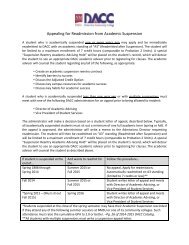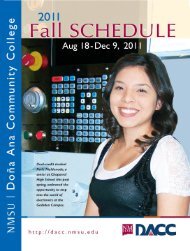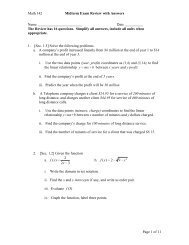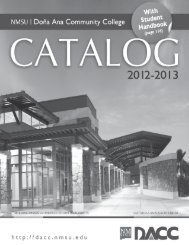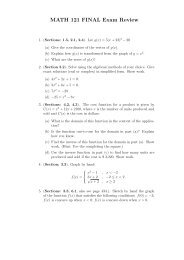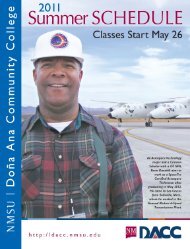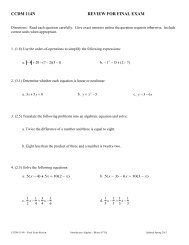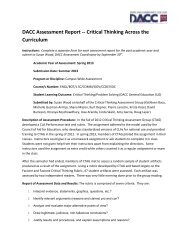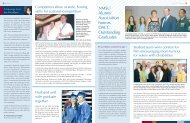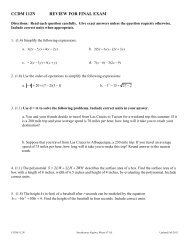online - Dona Ana Community College - New Mexico State University
online - Dona Ana Community College - New Mexico State University
online - Dona Ana Community College - New Mexico State University
Create successful ePaper yourself
Turn your PDF publications into a flip-book with our unique Google optimized e-Paper software.
D O Ñ A A N A C O M M U N I T Y C O L L E G E<br />
72<br />
CCDR 110 N Effective <strong>College</strong> Reading<br />
3 cr. (2+2P)<br />
Provides a variety of strategies for effective reading and studying at the<br />
college level. Emphasis on reading across disciplines. Course earns institutional<br />
credit but will not count towards degree requirements. Prerequisite:<br />
COMPASS score 64 on reading section.<br />
CCDS—<strong>Community</strong> <strong>College</strong> Developmental<br />
Studies<br />
CCDS 104 N Comprehensive Reading Development 4 cr. (3+2P)<br />
Integration of basic reading skills, including vocabulary development,<br />
text comprehension, and critical reading skills. RR applicable.<br />
CCDS 109 N Study Skills for Reading<br />
1-3 cr.<br />
Individualized reading skill strategies necessary for success in college<br />
classroom. May be repeated for a maximum of 3 credits. Graded traditional<br />
or S/U.<br />
CCDS 111 N Study Skills for Math<br />
1-3 cr.<br />
Individualized study skill strategies necessary for success in the math<br />
classroom. May be repeated for a maximum of 3 credits.<br />
CCDS 113 N Study Skills for English<br />
1-3 cr.<br />
Individualized study skill strategies necessary for success in the composition<br />
classroom. May be repeated for a maximum of 3 credits.<br />
CHEM—Chemistry<br />
CHEM 110G Principles and Applications of Chemistry 4 cr. (3+3P)<br />
A survey of the properties and uses of the elements and their compounds.<br />
In addition to classical chemistry, attention is paid to the materials from<br />
which consumer products are made, to the production of energy, and to<br />
environmental considerations. Prerequisite: 3 years of high school math<br />
or CCDM 114N.<br />
CHSS—Health and Social Services <strong>College</strong> of<br />
Health and Social Services<br />
CHSS 100 Introduction to Health and Social Services 1 cr.<br />
Introduction to professional opportunities in nursing, social work, public<br />
health, community health, and environmental/occupational health.<br />
Graded S/U.<br />
CHSS 101 Overview of Health and <strong>Community</strong> Services 3 cr.<br />
Health and community service professions with emphasis on public<br />
health, community health education, and environmental/occupational<br />
health.<br />
CHSS 216 Ethical and Research Issues in Human and<br />
<strong>Community</strong> Service<br />
3 cr.<br />
Ethical and legal responsibilities of health personnel with emphasis on<br />
research applications. May not receive credit for both CHSS 216 and<br />
CHSS 316. Branches only.<br />
CHSS 295 Leadership/Mentorship Training for the CHSS<br />
Ambassadors Program<br />
1 cr.<br />
Leadership development for volunteers serving as CHSS ambassadors.<br />
Focus on public relations and CHSS undergraduate degree programs.<br />
Prerequisite: consent of instructor. Graded S/U.<br />
CHSS 299 Service Learning Experience in Human<br />
and <strong>Community</strong> Services<br />
1-4 cr. (30P)<br />
Exploration of contemporary social, civic, economic and ethical problems<br />
that require student participation in collaborative efforts within the<br />
community. Requires 30 clock hours of community based service for<br />
each credit. Prerequisite: CHSS 101 or consent of instructor. May be<br />
repeated for a maximum of 4 credits. Graded S/U.<br />
CMT—Creative Media Technologies<br />
CMT 100 Introduction to Visual Communications<br />
3 cr.<br />
Overview of the process of crafting a digital product from conception to<br />
final. Incorporates basic principles of art and design, typography, layout,<br />
color and imagery, logos and advertising basics. Same as OEGR 105.<br />
CMT 105 Film Crew Training I<br />
9 cr.<br />
Introduction and hands-on experience in all craft areas of film production.<br />
CMT 108 Introduction to Media Technologies<br />
3 cr.<br />
Introduction to the various media technologies. Includes a basic survey<br />
of current digital graphs software application. Same as OEGR 108.<br />
CMT 110 Introduction to Web Portfolio Design<br />
1 cr.<br />
Basics of creating a web presence for digital portfolios or for personal<br />
use.<br />
CMT 115 Photography and Digital Imaging<br />
3 cr. (2+2P)<br />
Principles and techniques of photography using digital equipment with<br />
an emphasis on lighting, focus, composition, and special effects. May be<br />
repeated for a maximum of 6 credits.<br />
CMT 115 Digital Photography and Imaging I<br />
3 cr. (2+2P)<br />
Principles and techniques of photography using digital equipment with<br />
an emphasis on lighting, focus, and composition.<br />
CMT 120 Introduction to Creative Media<br />
3 cr. (2+2P)<br />
Exploration and discovery of the creative processes through art, music,<br />
theater, narrative, and other avenues.<br />
CMT 130 Introduction to Web Design<br />
3 cr. (2P)<br />
Introduction to web development techniques, theory, and design. Incorporates<br />
HTML and industry-standard web editing software in developing<br />
various web sites.<br />
CMT 135 Introduction to 3D Computer Animation 3 cr. (2+4P)<br />
Learning to work in a 3D environment. Introduction to the basics of<br />
modeling, animation, dynamics, and rendering. Working with polygons,<br />
NURBS and subdivisions, and editing in multiple interfaces. May be repeated<br />
for a maximum of 6 credits.<br />
CMT 140 Print Media I<br />
3 cr. (2+2P)<br />
Creation and design of publications and presentation materials using<br />
page layout software. May be repeated for a maximum of 6 credits.<br />
CMT 142 Computer Illustration<br />
3 cr. (2+2P)<br />
Preparation of digital graphics with a vector or draw program for use in<br />
print, web, video, animations, and multimedia. May be repeated for a<br />
maximum of 6 credits.<br />
CMT 145 Image Processing I<br />
3 cr. (2+2P)<br />
Design and creation of digital graphics using a raster or bitmap program<br />
for use in print, multimedia, video , animation and web. May be repeated<br />
for a maximum of 6 credits.<br />
CMT 146 Digital Foundations<br />
4 cr. (2+4P)<br />
Accelerated course covering concepts and techniques of industry-standard<br />
raster and vector graphics programs with focus on design and application.<br />
May be repeated for a maximum of 8 credits.<br />
CMT 150 2D Animation<br />
3 cr. (2+2P)<br />
Concepts and techniques in storyboarding and creating 2D animations<br />
for video, web, and multimedia. Prerequisite: CMT 142 or CMT 146 or<br />
OEGR 170. May be repeated for a maximum of 6 credits.<br />
CMT 155 Selected Topics<br />
1-4 cr.<br />
Specific titles to be announced in the Schedule of Classes. May be repeated<br />
for a maximum of 18 credits. Same as OEGR 155.<br />
CMT 156 Film Crew Training II<br />
9 cr.<br />
In-depth training in specific craft areas. Prerequisite: CMT 105.<br />
CMT 160 Modeling and Animation<br />
3 cr. (2+2P)<br />
Building on student’s knowledge of 2D animation, covers modeling and<br />
animating objects and scenes in a 3D environment using various camera<br />
and lighting effects. Prerequisite: CMT 150 or OEDG 276. May be<br />
repeated for a maximum of 6 credits.<br />
CMT 170 History of Film: A Global Perspective<br />
3 cr.<br />
Explores the history of cinema from the earliest 19th century developments<br />
to the present digital video revolution. Offers students a broader<br />
base of understanding of the tools and methodologies used in the craft.<br />
CMT 175 Character Rigging and Animation<br />
3 cr. (2+4P)<br />
In depth study of various character skeletal building, rigging, and skinning<br />
techniques. Further study into kinematics, constraints, set driven<br />
keys, lattices, flexors and clusters. Introduction to both skeletal and<br />
blend shape facial animation, and technical and aesthetic animation<br />
techniques used to create believable and emotion driven animations.



